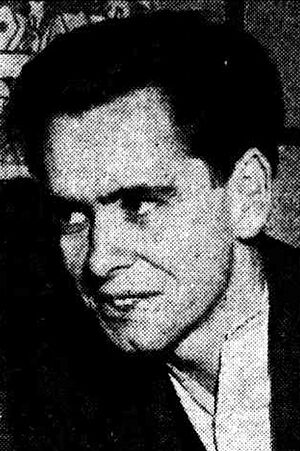Bernard Smith (art historian) facts for kids
Bernard William Smith (born October 3, 1916 – died September 2, 2011) was a very important Australian expert on art. He was an art historian (someone who studies the history of art) and an art critic (someone who judges and writes about art). Many people see him as the person who started the study of Australian art history. His book Place, Taste and Tradition is a key book about Australian art. After his wife passed away, he helped create the Kate Challis RAKA award. This was one of the first awards in Australia for Indigenous artists and writers.
Contents
Bernard Smith's Early Life and Education
Bernard Smith was born in Balmain, Sydney, on October 3, 1916. He had a tough start to life and grew up in foster care. In 1941, he married his first wife, Kate Challis. She passed away in 1989.
Smith studied at the University of Sydney. From 1935 to 1944, he worked as a teacher for the NSW Department of Education. After that, he became an education officer. He helped with art exhibitions that traveled to different parts of the country for the Art Gallery of New South Wales.
Studying Art in London
In 1948, Bernard Smith won a special scholarship. This allowed him to study art in London, England. He went to the Warburg and Courtauld Institutes at the University of London. When he returned to Australia in 1951, he went back to his job at the Art Gallery.
In 1952, Smith received another scholarship. This time, it was to the new Australian National University. There, he earned his PhD degree. A shorter version of his important research, "European Vision and the South Pacific," was published in 1950. It later became a full book in 1960.
Teaching and Art Criticism
From 1955 to 1967, Bernard Smith taught at the University of Melbourne. He was a lecturer in the Fine Arts Department. In 1959, he brought together a group of seven new painters. They were known as the Antipodeans. This group held their only art show in August 1959. Smith also helped them write The Antipodean Manifesto, which was like their statement of beliefs about art.
Between 1963 and 1966, he also worked as an art critic for The Age newspaper in Melbourne. He wrote reviews and opinions about art.
Leading the Power Institute
In 1967, Bernard Smith and his wife moved to Sydney. Smith became the first Professor of Contemporary Art. He also became the director of the Power Institute of Fine Arts at the University of Sydney. He held this important job until he retired in 1977.
During this time, he also got involved with an art workshop called Tin Sheds. He had some disagreements with its founders about what the workshop should be. He wanted to call it the Fine Arts University Workshop.
After retiring in 1977, the Smiths moved back to Melbourne. Bernard Smith became the president of the Australian Academy of the Humanities. He held this role until 1980. Later, he was a professor in the art history department at the University of Melbourne.
Important Contributions and Awards
In 1980, Bernard Smith gave a series of talks called "The Boyer Lectures." The theme was "The Spectre of Trunganini." In these talks, he spoke out against the Australian government's policy. This policy involved taking Aboriginal and Torres Strait Islander children away from their families. This sad period is now known as the Stolen Generations. Smith was one of the first people to publicly criticize this policy.
Bernard Smith received a special award from France. He was made a Chevalier (Knight) of the Ordre des Arts et des Lettres. This award recognizes important contributions to arts and literature.
He also started the annual Kate Challis RAKA Award. This award is worth A$20,000. He created it to honor his first wife, Kate Challis. It helps support Indigenous artists and writers.
Books by Bernard Smith
Bernard Smith wrote many important books about art and history. Here are some of them:
- Place, Taste and Tradition: A Study of Australian Art Since 1788 (1945)
- European Vision and the South Pacific, 1768–1850: A Study in the History of Art and Ideas (1960)
- Australian Painting, 1788–2000 (1962, updated several times)
- The Antipodean Manifesto: Essays in Art and History (1975)
- The Spectre of Truganini (1980)
- The Boy Adeodatus—The Portrait of a Lucky Young Bastard (1984)
- The Art of Captain Cook's Voyages (with Rüdiger Joppien, three volumes, 1985–1987)
- Modernism's History: A Study in Twentieth-century Art and Ideas (1998)
Images for kids



